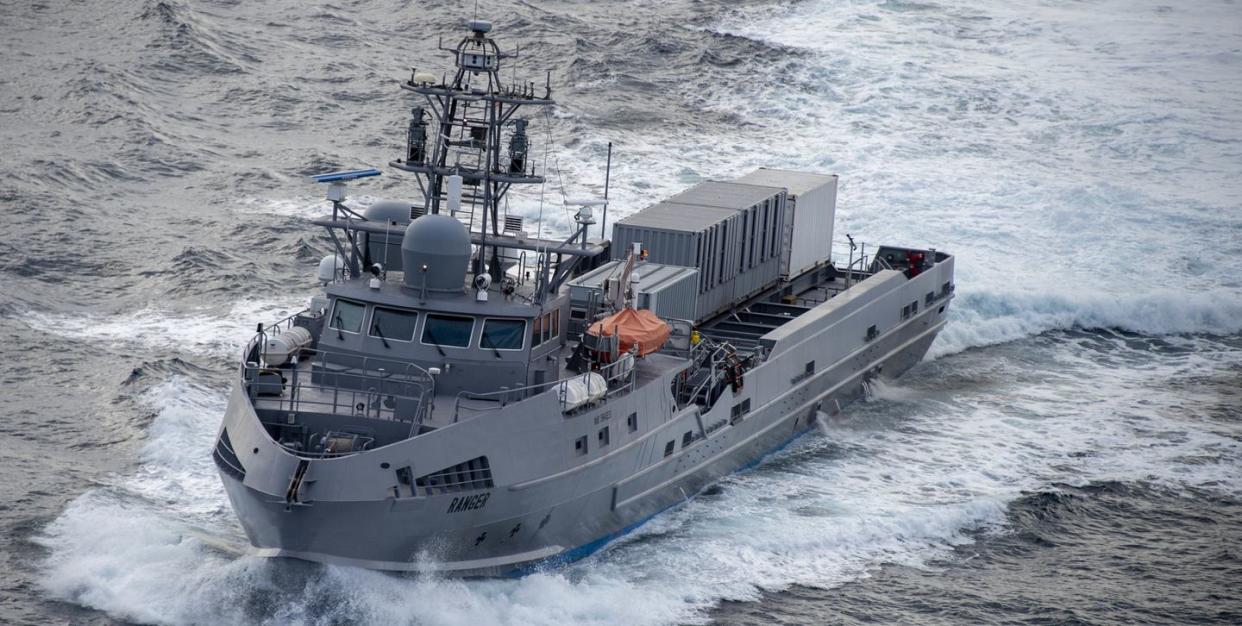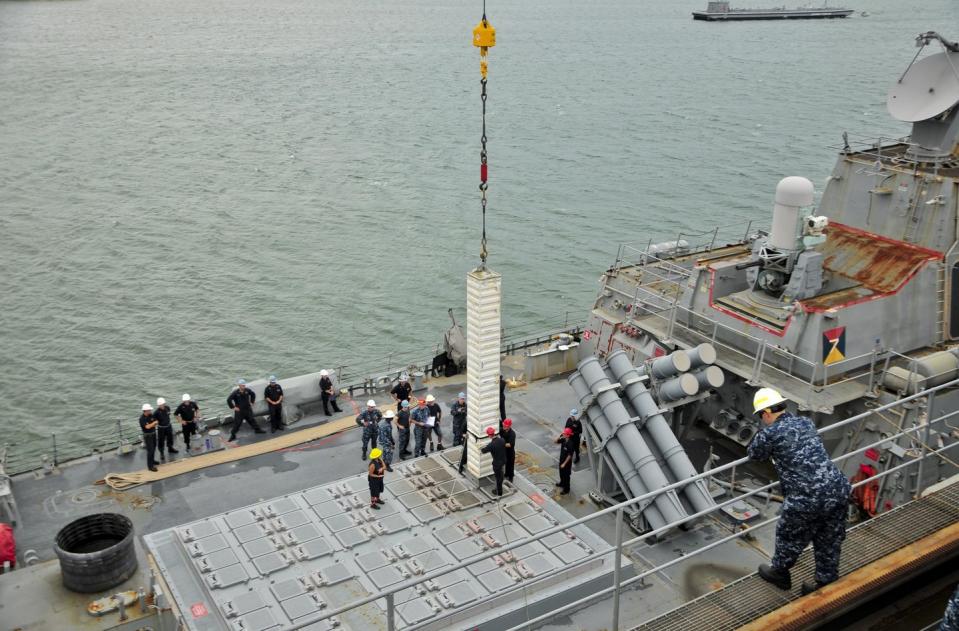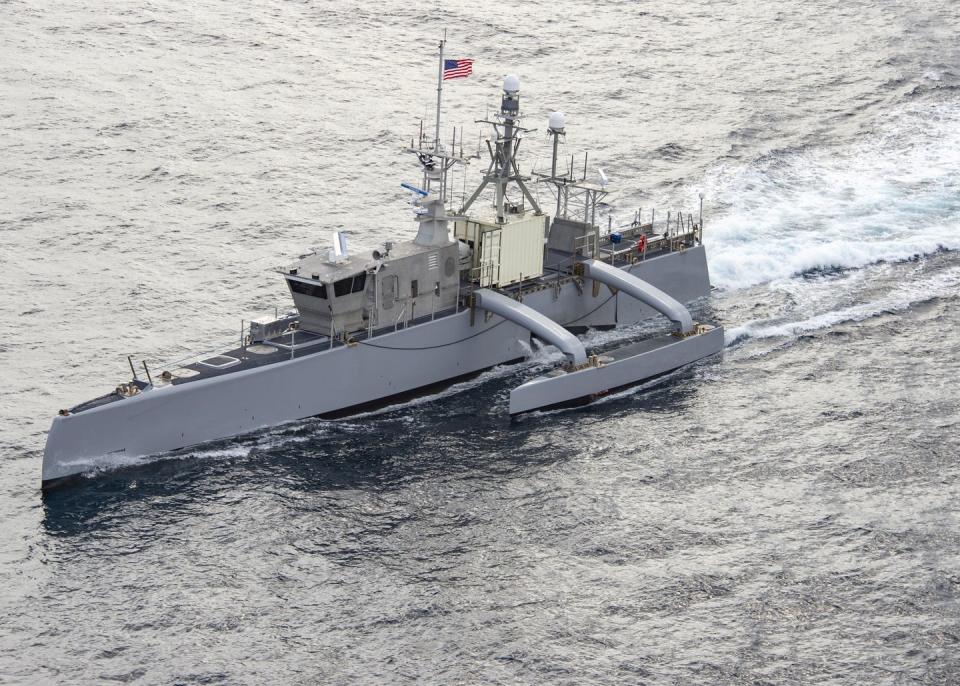Here Comes the Navy's Latest Robo-Ship, Testing Out a ‘Ghost Fleet’ Concept

The U.S. Navy christened Mariner as the service’s third medium unmanned surface vehicle.
The Navy is testing ships like Mariner to determine how unmanned ships might operate alongside manned warships.
Ultimately, the Navy could have as many as 150 unmanned ships, acting as force multipliers for the manned fleet.
Last week, the Navy christened a new “Ghost Fleet” ship, an unmanned surface vessel called Mariner. Designed to operate without a human crew, the ship will act as a test vehicle for the service’s manned/unmanned ship program, which envisions manned warships going into battle accompanied by one or more unmanned escorts. The program, known as Ghost Fleet Overlord, is probably the Navy’s best chance at affordably growing the fleet and fleet capabilities.
🚢 Don’t miss any of our best-in-class military and defense coverage. Join our squad.
Mariner was launched in Annapolis, Maryland, the home of the U.S. Naval Academy. The ship is the third of four medium unmanned surface vehicles, or MUSVs, the service is using to test unmanned ship concepts. The first two ships are Nomad and Ranger, and a fourth ship, Vanguard, is under construction.
See the game-changing, cross-domain, cross-service concepts the Strategic Capabilities Office and @USNavy are rapidly developing: an SM-6 launched from a modular launcher off of USV Ranger. Such innovation drives the future of joint capabilities. #DoDInnovates pic.twitter.com/yCG57lFcNW
— Department of Defense 🇺🇸 (@DeptofDefense) September 3, 2021
According to U.S. Naval Institute News, Mariner was built by Gulf Craft, a Louisiana-based manufacturer of offshore supply ships for the oil and gas industry. Offshore supply ships typically require small crews and have long, flat payload beds in the rear to haul shipping containers and outsized cargoes. The Navy finds these beds useful for installing mission payloads and even missile launchers; in 2021 the service installed a modular launcher on the Ranger and launched an SM-6 high speed air defense/anti-ship missile from the unmanned ship.
The U.S. Navy is betting big on unmanned ships as a way to grow the fleet without busting its budget. The service, which currently has 300 warships, wants to grow to 523 by the year 2045, with 150 of those ships as “ghost ships.” Ghost ships are cheaper to build and, lacking human crews, are cheaper to operate. They can be sent on duller—or more dangerous—missions that don’t require human crews, and can operate autonomously on their own or alongside manned ships.

The Vital Role of Unmanned Ships
The first mission for unmanned ships will be as part of a manned/unmanned team of ships, for example as a floating magazine for manned warships. Ticonderoga-class guided missile cruisers are equipped with 122 MK 41 vertical launch missile silos, while Arleigh Burke-class destroyers are equipped with 90 or 96 silos. These silos accommodate a mix of anti-air, anti-ship, anti-submarine, and land attack cruise missiles. In a sustained engagement, ships might run out of certain types of missiles, and the Navy has no way of reloading the silos at sea. A manned warship might be assigned one or more unmanned ships, each bristling with additional missiles, bolstering its firepower in both attack and defense.
In the event that enemy missiles get through the defensive screen, the unmanned ship could even take position and distract enemy missiles away from the manned ship, sacrificing itself and saving lives.

What a Robo-Ship Could Do in the Future
As artificial intelligence advances, a ghost ship could be outfitted with hardware mission payloads that allow it to conduct missions autonomously. A MUSV could be equipped with an anti-submarine warfare module, including a towed sonar array, letting it patrol a patch of ocean for weeks on end. Once the sonar locates a possible enemy submarine, the ship would relay the sonar contact data to a human operator thousands of miles away. After determining there are no friendly submarines in the area, the human operator could then order the ghost ship to launch an MK 54 anti-submarine torpedo at the mystery contact.
The anti-submarine warfare scenario is highly efficient, cost-effective, and bad news for enemy submarines. Instead of one $1.8 billion Burke-class destroyer and nearly 400 humans patrolling one narrow stretch of water, the Navy could instead patrol twelve times as much water with twelve unmanned ships costing $150 million apiece, collectively controlled by as few as a dozen humans.
Unmanned ships, like unmanned planes, tanks, and systems, are here to save the Pentagon from unaffordable weapons systems. Cheap and capable, unmanned systems promise to reverse the trend of smaller numbers of increasingly unaffordable weapons. How they will ultimately perform, especially on a mixed battlefield crowded with civilians, or in this case civilian shipping, remains to be seen.
You Might Also Like

